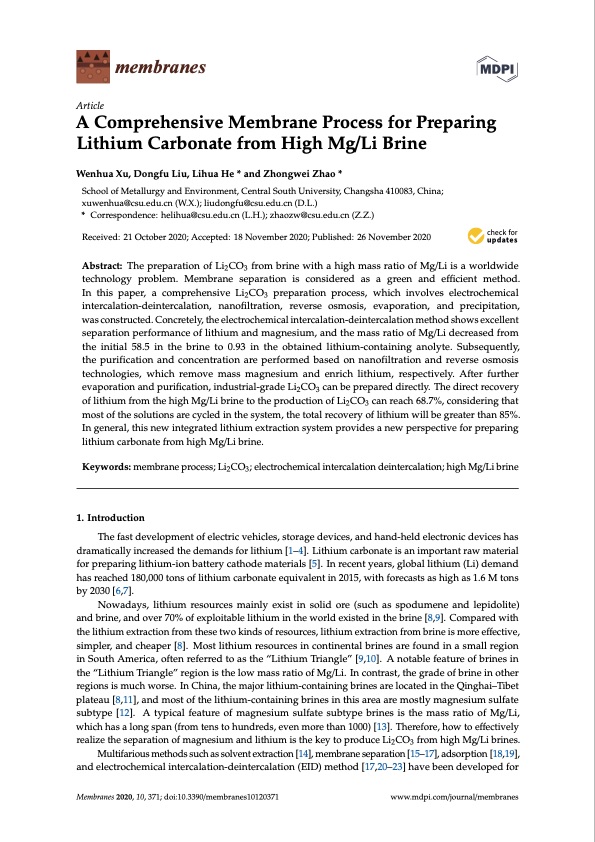
PDF Publication Title:
Text from PDF Page: 001
membranes Article A Comprehensive Membrane Process for Preparing Lithium Carbonate from High Mg/Li Brine Wenhua Xu, Dongfu Liu, Lihua He * and Zhongwei Zhao * School of Metallurgy and Environment, Central South University, Changsha 410083, China; xuwenhua@csu.edu.cn (W.X.); liudongfu@csu.edu.cn (D.L.) * Correspondence: helihua@csu.edu.cn (L.H.); zhaozw@csu.edu.cn (Z.Z.) Received: 21 October 2020; Accepted: 18 November 2020; Published: 26 November 2020 Abstract: The preparation of Li2CO3 from brine with a high mass ratio of Mg/Li is a worldwide technology problem. Membrane separation is considered as a green and efficient method. In this paper, a comprehensive Li2CO3 preparation process, which involves electrochemical intercalation-deintercalation, nanofiltration, reverse osmosis, evaporation, and precipitation, was constructed. Concretely, the electrochemical intercalation-deintercalation method shows excellent separation performance of lithium and magnesium, and the mass ratio of Mg/Li decreased from the initial 58.5 in the brine to 0.93 in the obtained lithium-containing anolyte. Subsequently, the purification and concentration are performed based on nanofiltration and reverse osmosis technologies, which remove mass magnesium and enrich lithium, respectively. After further evaporation and purification, industrial-grade Li2CO3 can be prepared directly. The direct recovery of lithium from the high Mg/Li brine to the production of Li2CO3 can reach 68.7%, considering that most of the solutions are cycled in the system, the total recovery of lithium will be greater than 85%. In general, this new integrated lithium extraction system provides a new perspective for preparing lithium carbonate from high Mg/Li brine. Keywords: membrane process; Li2CO3; electrochemical intercalation deintercalation; high Mg/Li brine 1. Introduction The fast development of electric vehicles, storage devices, and hand-held electronic devices has dramatically increased the demands for lithium [1–4]. Lithium carbonate is an important raw material for preparing lithium-ion battery cathode materials [5]. In recent years, global lithium (Li) demand has reached 180,000 tons of lithium carbonate equivalent in 2015, with forecasts as high as 1.6 M tons by 2030 [6,7]. Nowadays, lithium resources mainly exist in solid ore (such as spodumene and lepidolite) and brine, and over 70% of exploitable lithium in the world existed in the brine [8,9]. Compared with the lithium extraction from these two kinds of resources, lithium extraction from brine is more effective, simpler, and cheaper [8]. Most lithium resources in continental brines are found in a small region in South America, often referred to as the “Lithium Triangle” [9,10]. A notable feature of brines in the “Lithium Triangle” region is the low mass ratio of Mg/Li. In contrast, the grade of brine in other regions is much worse. In China, the major lithium-containing brines are located in the Qinghai–Tibet plateau [8,11], and most of the lithium-containing brines in this area are mostly magnesium sulfate subtype [12]. A typical feature of magnesium sulfate subtype brines is the mass ratio of Mg/Li, which has a long span (from tens to hundreds, even more than 1000) [13]. Therefore, how to effectively realize the separation of magnesium and lithium is the key to produce Li2CO3 from high Mg/Li brines. Multifarious methods such as solvent extraction [14], membrane separation [15–17], adsorption [18,19], and electrochemical intercalation-deintercalation (EID) method [17,20–23] have been developed for Membranes 2020, 10, 371; doi:10.3390/membranes10120371 www.mdpi.com/journal/membranesPDF Image | Membrane Process for Preparing Lithium Carbonate

PDF Search Title:
Membrane Process for Preparing Lithium CarbonateOriginal File Name Searched:
membranes-10-00371.pdfDIY PDF Search: Google It | Yahoo | Bing
Product and Development Focus for Infinity Turbine
ORC Waste Heat Turbine and ORC System Build Plans: All turbine plans are $10,000 each. This allows you to build a system and then consider licensing for production after you have completed and tested a unit.Redox Flow Battery Technology: With the advent of the new USA tax credits for producing and selling batteries ($35/kW) we are focussing on a simple flow battery using shipping containers as the modular electrolyte storage units with tax credits up to $140,000 per system. Our main focus is on the salt battery. This battery can be used for both thermal and electrical storage applications. We call it the Cogeneration Battery or Cogen Battery. One project is converting salt (brine) based water conditioners to simultaneously produce power. In addition, there are many opportunities to extract Lithium from brine (salt lakes, groundwater, and producer water).Salt water or brine are huge sources for lithium. Most of the worlds lithium is acquired from a brine source. It's even in seawater in a low concentration. Brine is also a byproduct of huge powerplants, which can now use that as an electrolyte and a huge flow battery (which allows storage at the source).We welcome any business and equipment inquiries, as well as licensing our turbines for manufacturing.| CONTACT TEL: 608-238-6001 Email: greg@infinityturbine.com | RSS | AMP |